Analysis of Taxation Consequences for Sophie and Kate's Case
VerifiedAdded on 2022/12/18
|8
|1735
|77
Homework Assignment
AI Summary
This assignment analyzes the taxation consequences for Sophie, the owner of a beauty clinic, and her client Kate, following an incident involving a faulty laser machine. The analysis examines various tax implications, including capital gains tax (CGT) on compensation for loss of reputation, assessable income from compensation for loss of income, and the treatment of reimbursed legal fees for Sophie. For Kate, the assignment explores the tax implications of a lump sum received for pain and suffering, the deductibility of medical expenses, and the tax treatment of interest earned on a lump sum payment. The assignment references relevant case law and legislation, such as the ITAA 1997, to support its conclusions. The analysis considers the nature of the compensation received, whether it relates to personal injury, loss of income, or reimbursement of expenses, and how these factors affect the tax treatment of the amounts received. The assignment provides a comprehensive overview of the tax consequences for both Sophie and Kate, offering insights into Australian taxation law.
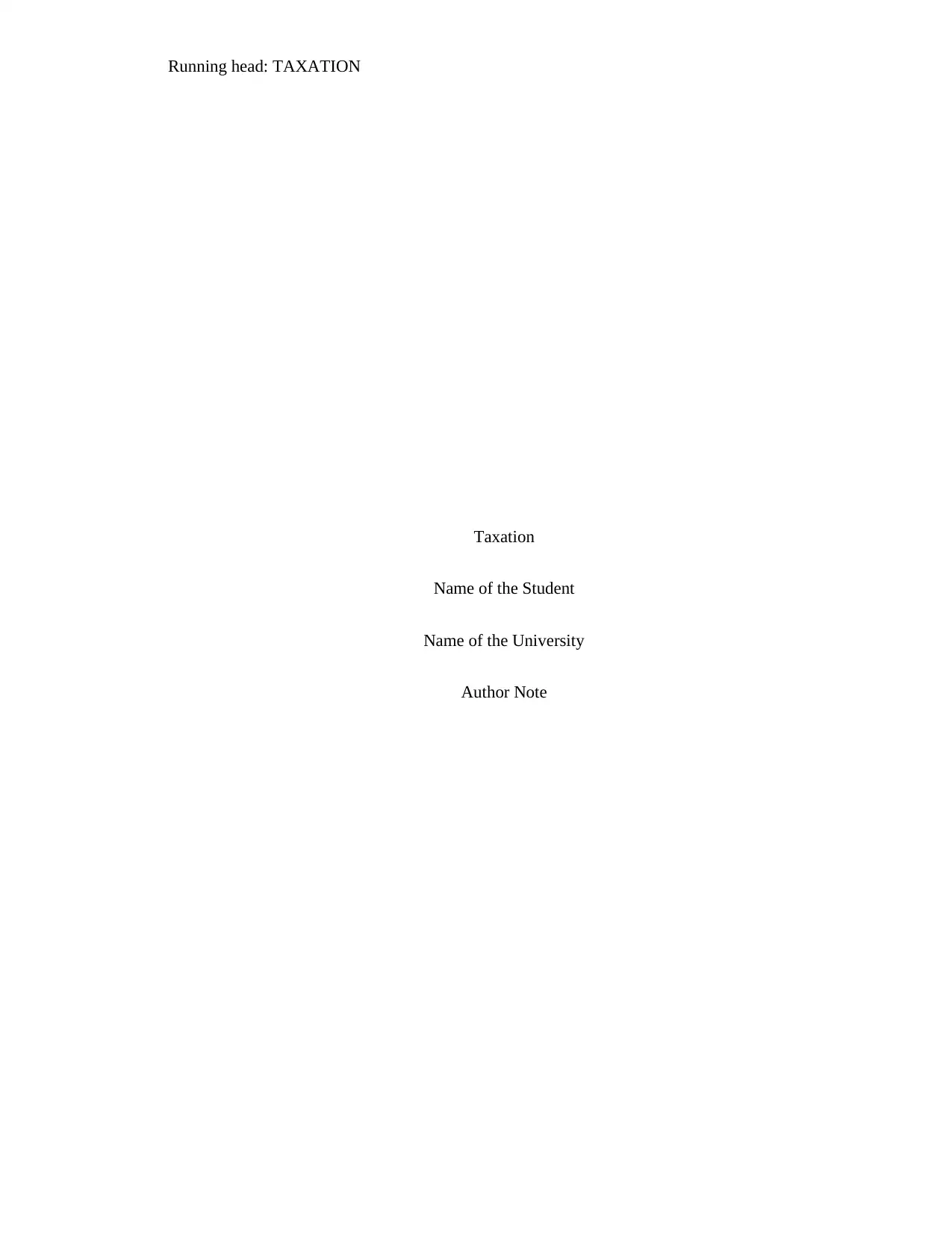
Running head: TAXATION
Taxation
Name of the Student
Name of the University
Author Note
Taxation
Name of the Student
Name of the University
Author Note
Paraphrase This Document
Need a fresh take? Get an instant paraphrase of this document with our AI Paraphraser
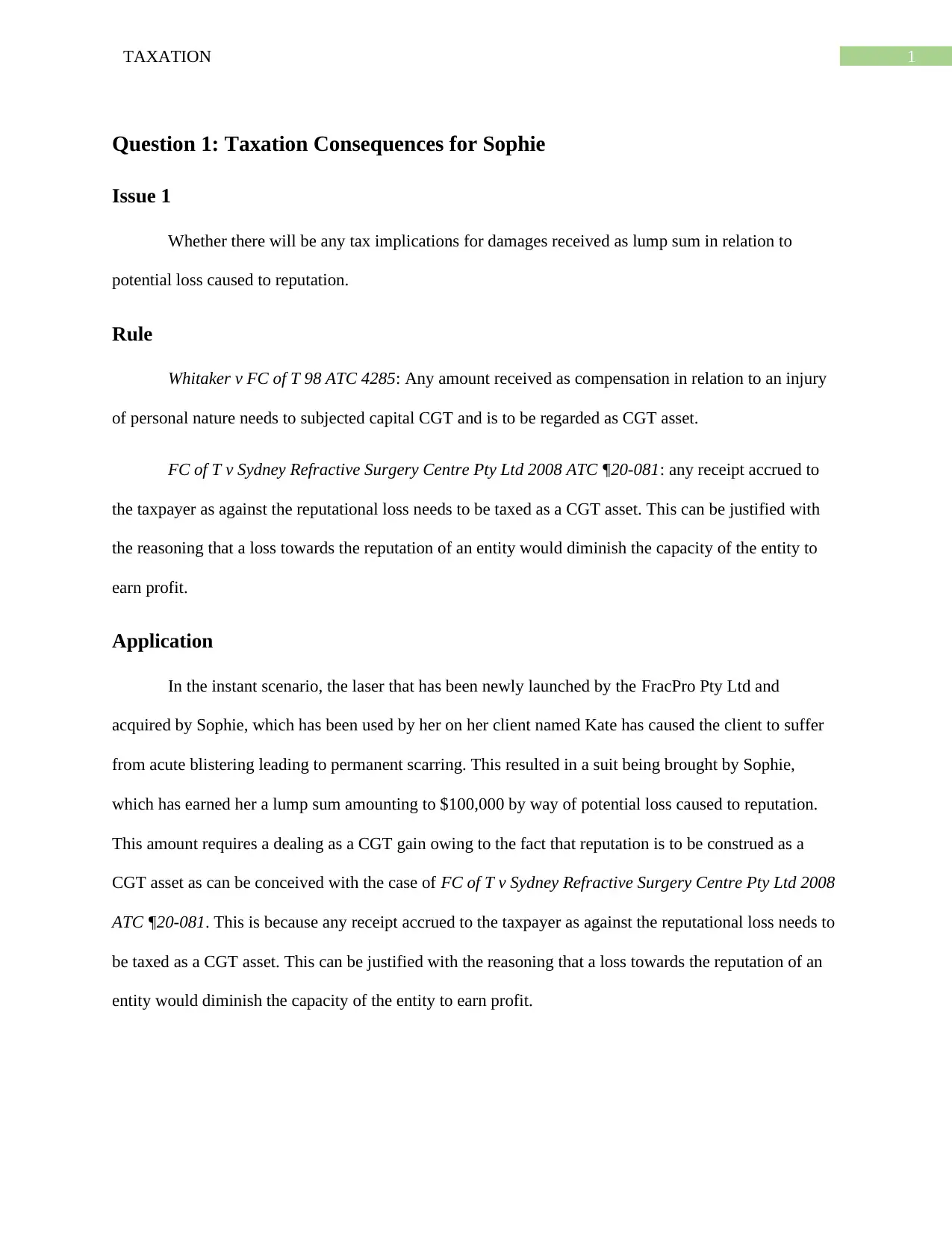
1TAXATION
Question 1: Taxation Consequences for Sophie
Issue 1
Whether there will be any tax implications for damages received as lump sum in relation to
potential loss caused to reputation.
Rule
Whitaker v FC of T 98 ATC 4285: Any amount received as compensation in relation to an injury
of personal nature needs to subjected capital CGT and is to be regarded as CGT asset.
FC of T v Sydney Refractive Surgery Centre Pty Ltd 2008 ATC ¶20-081: any receipt accrued to
the taxpayer as against the reputational loss needs to be taxed as a CGT asset. This can be justified with
the reasoning that a loss towards the reputation of an entity would diminish the capacity of the entity to
earn profit.
Application
In the instant scenario, the laser that has been newly launched by the FracPro Pty Ltd and
acquired by Sophie, which has been used by her on her client named Kate has caused the client to suffer
from acute blistering leading to permanent scarring. This resulted in a suit being brought by Sophie,
which has earned her a lump sum amounting to $100,000 by way of potential loss caused to reputation.
This amount requires a dealing as a CGT gain owing to the fact that reputation is to be construed as a
CGT asset as can be conceived with the case of FC of T v Sydney Refractive Surgery Centre Pty Ltd 2008
ATC ¶20-081. This is because any receipt accrued to the taxpayer as against the reputational loss needs to
be taxed as a CGT asset. This can be justified with the reasoning that a loss towards the reputation of an
entity would diminish the capacity of the entity to earn profit.
Question 1: Taxation Consequences for Sophie
Issue 1
Whether there will be any tax implications for damages received as lump sum in relation to
potential loss caused to reputation.
Rule
Whitaker v FC of T 98 ATC 4285: Any amount received as compensation in relation to an injury
of personal nature needs to subjected capital CGT and is to be regarded as CGT asset.
FC of T v Sydney Refractive Surgery Centre Pty Ltd 2008 ATC ¶20-081: any receipt accrued to
the taxpayer as against the reputational loss needs to be taxed as a CGT asset. This can be justified with
the reasoning that a loss towards the reputation of an entity would diminish the capacity of the entity to
earn profit.
Application
In the instant scenario, the laser that has been newly launched by the FracPro Pty Ltd and
acquired by Sophie, which has been used by her on her client named Kate has caused the client to suffer
from acute blistering leading to permanent scarring. This resulted in a suit being brought by Sophie,
which has earned her a lump sum amounting to $100,000 by way of potential loss caused to reputation.
This amount requires a dealing as a CGT gain owing to the fact that reputation is to be construed as a
CGT asset as can be conceived with the case of FC of T v Sydney Refractive Surgery Centre Pty Ltd 2008
ATC ¶20-081. This is because any receipt accrued to the taxpayer as against the reputational loss needs to
be taxed as a CGT asset. This can be justified with the reasoning that a loss towards the reputation of an
entity would diminish the capacity of the entity to earn profit.
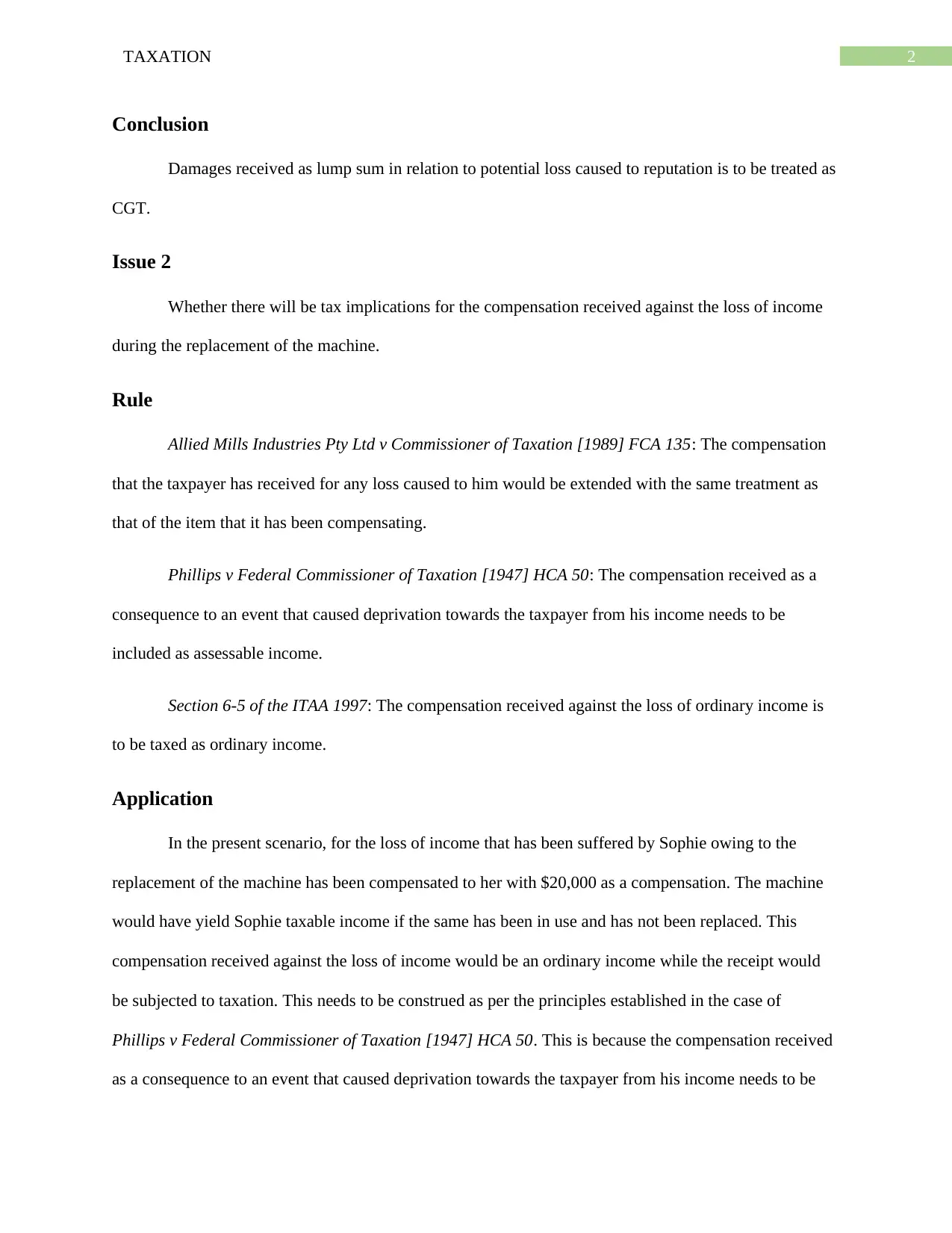
2TAXATION
Conclusion
Damages received as lump sum in relation to potential loss caused to reputation is to be treated as
CGT.
Issue 2
Whether there will be tax implications for the compensation received against the loss of income
during the replacement of the machine.
Rule
Allied Mills Industries Pty Ltd v Commissioner of Taxation [1989] FCA 135: The compensation
that the taxpayer has received for any loss caused to him would be extended with the same treatment as
that of the item that it has been compensating.
Phillips v Federal Commissioner of Taxation [1947] HCA 50: The compensation received as a
consequence to an event that caused deprivation towards the taxpayer from his income needs to be
included as assessable income.
Section 6-5 of the ITAA 1997: The compensation received against the loss of ordinary income is
to be taxed as ordinary income.
Application
In the present scenario, for the loss of income that has been suffered by Sophie owing to the
replacement of the machine has been compensated to her with $20,000 as a compensation. The machine
would have yield Sophie taxable income if the same has been in use and has not been replaced. This
compensation received against the loss of income would be an ordinary income while the receipt would
be subjected to taxation. This needs to be construed as per the principles established in the case of
Phillips v Federal Commissioner of Taxation [1947] HCA 50. This is because the compensation received
as a consequence to an event that caused deprivation towards the taxpayer from his income needs to be
Conclusion
Damages received as lump sum in relation to potential loss caused to reputation is to be treated as
CGT.
Issue 2
Whether there will be tax implications for the compensation received against the loss of income
during the replacement of the machine.
Rule
Allied Mills Industries Pty Ltd v Commissioner of Taxation [1989] FCA 135: The compensation
that the taxpayer has received for any loss caused to him would be extended with the same treatment as
that of the item that it has been compensating.
Phillips v Federal Commissioner of Taxation [1947] HCA 50: The compensation received as a
consequence to an event that caused deprivation towards the taxpayer from his income needs to be
included as assessable income.
Section 6-5 of the ITAA 1997: The compensation received against the loss of ordinary income is
to be taxed as ordinary income.
Application
In the present scenario, for the loss of income that has been suffered by Sophie owing to the
replacement of the machine has been compensated to her with $20,000 as a compensation. The machine
would have yield Sophie taxable income if the same has been in use and has not been replaced. This
compensation received against the loss of income would be an ordinary income while the receipt would
be subjected to taxation. This needs to be construed as per the principles established in the case of
Phillips v Federal Commissioner of Taxation [1947] HCA 50. This is because the compensation received
as a consequence to an event that caused deprivation towards the taxpayer from his income needs to be
⊘ This is a preview!⊘
Do you want full access?
Subscribe today to unlock all pages.

Trusted by 1+ million students worldwide
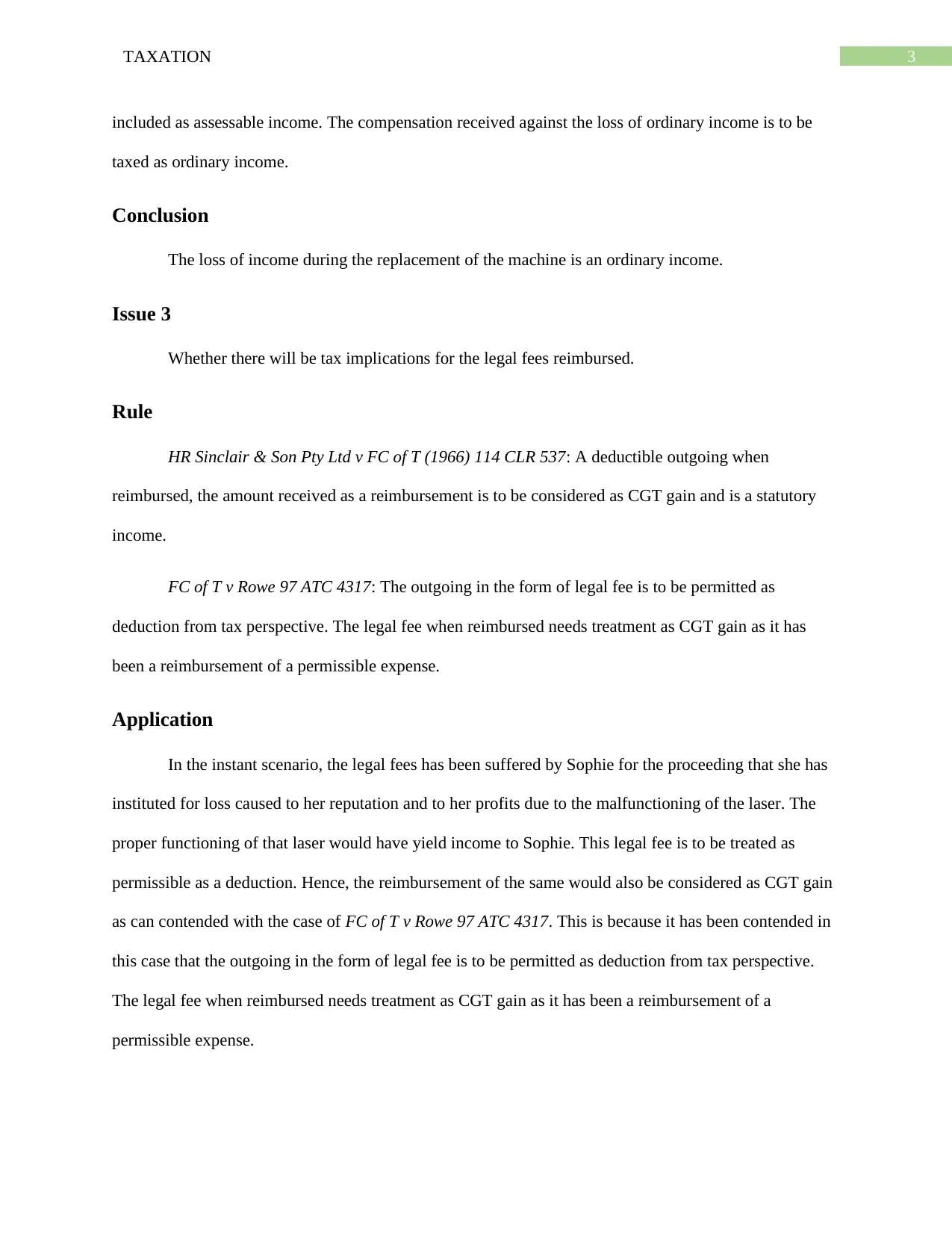
3TAXATION
included as assessable income. The compensation received against the loss of ordinary income is to be
taxed as ordinary income.
Conclusion
The loss of income during the replacement of the machine is an ordinary income.
Issue 3
Whether there will be tax implications for the legal fees reimbursed.
Rule
HR Sinclair & Son Pty Ltd v FC of T (1966) 114 CLR 537: A deductible outgoing when
reimbursed, the amount received as a reimbursement is to be considered as CGT gain and is a statutory
income.
FC of T v Rowe 97 ATC 4317: The outgoing in the form of legal fee is to be permitted as
deduction from tax perspective. The legal fee when reimbursed needs treatment as CGT gain as it has
been a reimbursement of a permissible expense.
Application
In the instant scenario, the legal fees has been suffered by Sophie for the proceeding that she has
instituted for loss caused to her reputation and to her profits due to the malfunctioning of the laser. The
proper functioning of that laser would have yield income to Sophie. This legal fee is to be treated as
permissible as a deduction. Hence, the reimbursement of the same would also be considered as CGT gain
as can contended with the case of FC of T v Rowe 97 ATC 4317. This is because it has been contended in
this case that the outgoing in the form of legal fee is to be permitted as deduction from tax perspective.
The legal fee when reimbursed needs treatment as CGT gain as it has been a reimbursement of a
permissible expense.
included as assessable income. The compensation received against the loss of ordinary income is to be
taxed as ordinary income.
Conclusion
The loss of income during the replacement of the machine is an ordinary income.
Issue 3
Whether there will be tax implications for the legal fees reimbursed.
Rule
HR Sinclair & Son Pty Ltd v FC of T (1966) 114 CLR 537: A deductible outgoing when
reimbursed, the amount received as a reimbursement is to be considered as CGT gain and is a statutory
income.
FC of T v Rowe 97 ATC 4317: The outgoing in the form of legal fee is to be permitted as
deduction from tax perspective. The legal fee when reimbursed needs treatment as CGT gain as it has
been a reimbursement of a permissible expense.
Application
In the instant scenario, the legal fees has been suffered by Sophie for the proceeding that she has
instituted for loss caused to her reputation and to her profits due to the malfunctioning of the laser. The
proper functioning of that laser would have yield income to Sophie. This legal fee is to be treated as
permissible as a deduction. Hence, the reimbursement of the same would also be considered as CGT gain
as can contended with the case of FC of T v Rowe 97 ATC 4317. This is because it has been contended in
this case that the outgoing in the form of legal fee is to be permitted as deduction from tax perspective.
The legal fee when reimbursed needs treatment as CGT gain as it has been a reimbursement of a
permissible expense.
Paraphrase This Document
Need a fresh take? Get an instant paraphrase of this document with our AI Paraphraser
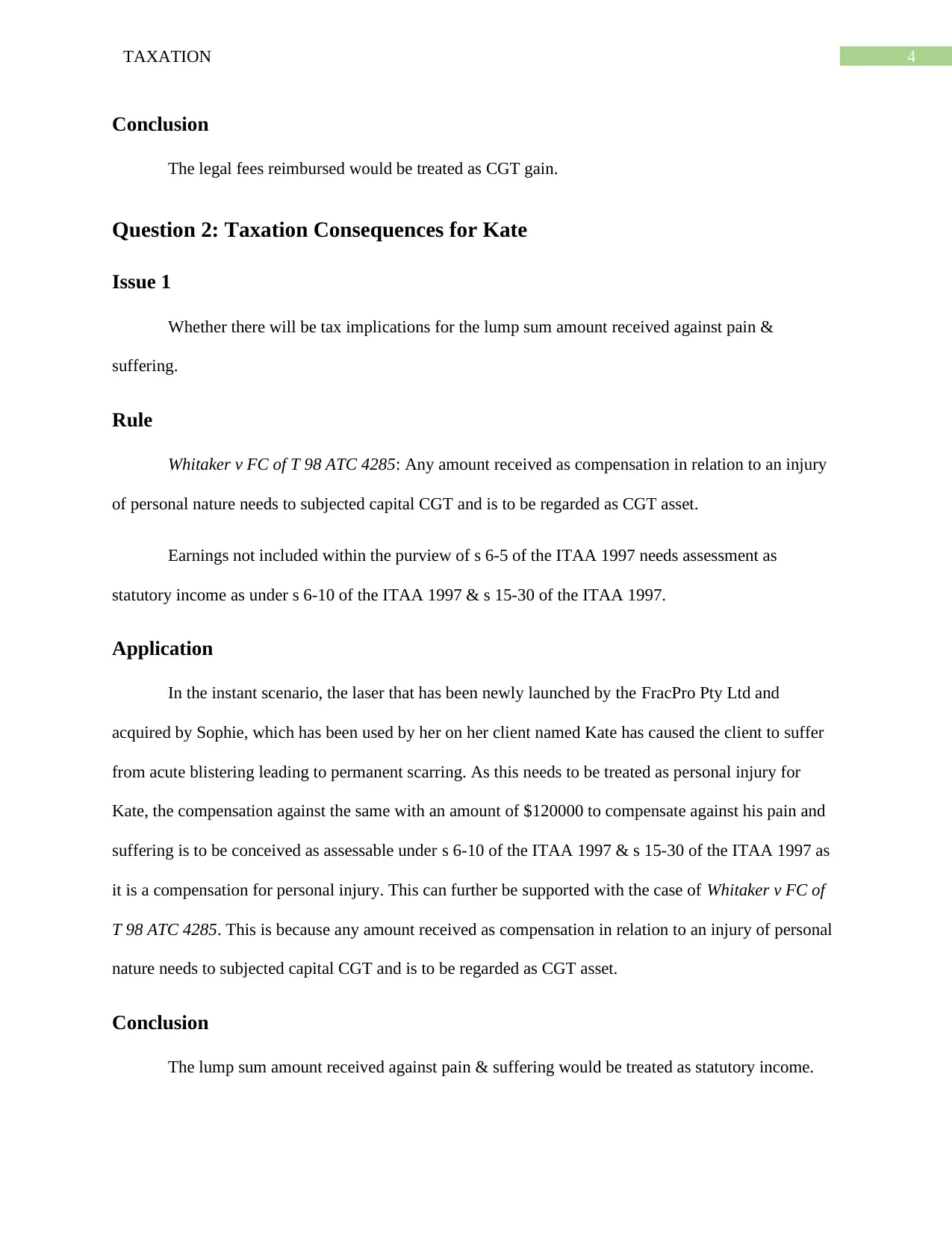
4TAXATION
Conclusion
The legal fees reimbursed would be treated as CGT gain.
Question 2: Taxation Consequences for Kate
Issue 1
Whether there will be tax implications for the lump sum amount received against pain &
suffering.
Rule
Whitaker v FC of T 98 ATC 4285: Any amount received as compensation in relation to an injury
of personal nature needs to subjected capital CGT and is to be regarded as CGT asset.
Earnings not included within the purview of s 6-5 of the ITAA 1997 needs assessment as
statutory income as under s 6-10 of the ITAA 1997 & s 15-30 of the ITAA 1997.
Application
In the instant scenario, the laser that has been newly launched by the FracPro Pty Ltd and
acquired by Sophie, which has been used by her on her client named Kate has caused the client to suffer
from acute blistering leading to permanent scarring. As this needs to be treated as personal injury for
Kate, the compensation against the same with an amount of $120000 to compensate against his pain and
suffering is to be conceived as assessable under s 6-10 of the ITAA 1997 & s 15-30 of the ITAA 1997 as
it is a compensation for personal injury. This can further be supported with the case of Whitaker v FC of
T 98 ATC 4285. This is because any amount received as compensation in relation to an injury of personal
nature needs to subjected capital CGT and is to be regarded as CGT asset.
Conclusion
The lump sum amount received against pain & suffering would be treated as statutory income.
Conclusion
The legal fees reimbursed would be treated as CGT gain.
Question 2: Taxation Consequences for Kate
Issue 1
Whether there will be tax implications for the lump sum amount received against pain &
suffering.
Rule
Whitaker v FC of T 98 ATC 4285: Any amount received as compensation in relation to an injury
of personal nature needs to subjected capital CGT and is to be regarded as CGT asset.
Earnings not included within the purview of s 6-5 of the ITAA 1997 needs assessment as
statutory income as under s 6-10 of the ITAA 1997 & s 15-30 of the ITAA 1997.
Application
In the instant scenario, the laser that has been newly launched by the FracPro Pty Ltd and
acquired by Sophie, which has been used by her on her client named Kate has caused the client to suffer
from acute blistering leading to permanent scarring. As this needs to be treated as personal injury for
Kate, the compensation against the same with an amount of $120000 to compensate against his pain and
suffering is to be conceived as assessable under s 6-10 of the ITAA 1997 & s 15-30 of the ITAA 1997 as
it is a compensation for personal injury. This can further be supported with the case of Whitaker v FC of
T 98 ATC 4285. This is because any amount received as compensation in relation to an injury of personal
nature needs to subjected capital CGT and is to be regarded as CGT asset.
Conclusion
The lump sum amount received against pain & suffering would be treated as statutory income.
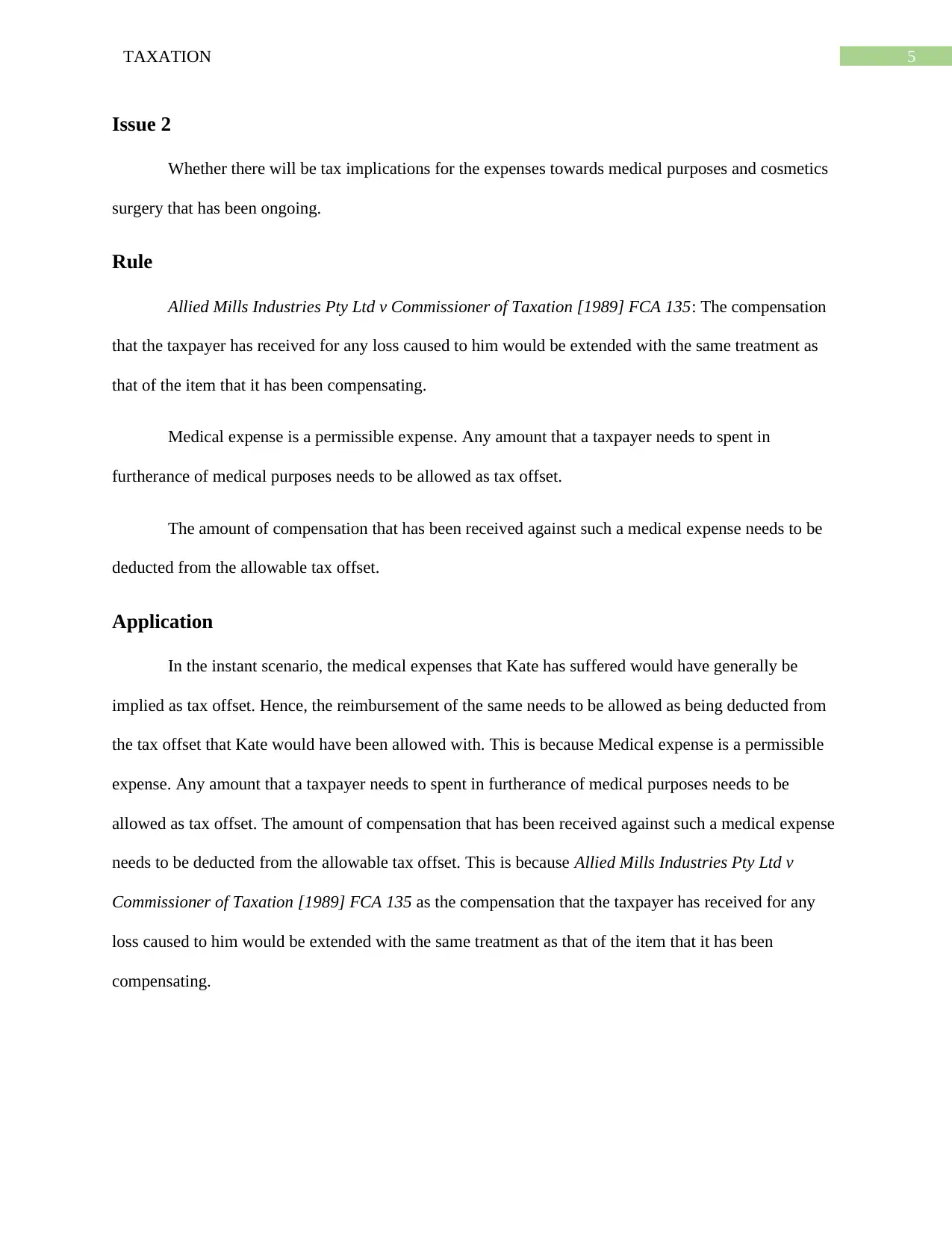
5TAXATION
Issue 2
Whether there will be tax implications for the expenses towards medical purposes and cosmetics
surgery that has been ongoing.
Rule
Allied Mills Industries Pty Ltd v Commissioner of Taxation [1989] FCA 135: The compensation
that the taxpayer has received for any loss caused to him would be extended with the same treatment as
that of the item that it has been compensating.
Medical expense is a permissible expense. Any amount that a taxpayer needs to spent in
furtherance of medical purposes needs to be allowed as tax offset.
The amount of compensation that has been received against such a medical expense needs to be
deducted from the allowable tax offset.
Application
In the instant scenario, the medical expenses that Kate has suffered would have generally be
implied as tax offset. Hence, the reimbursement of the same needs to be allowed as being deducted from
the tax offset that Kate would have been allowed with. This is because Medical expense is a permissible
expense. Any amount that a taxpayer needs to spent in furtherance of medical purposes needs to be
allowed as tax offset. The amount of compensation that has been received against such a medical expense
needs to be deducted from the allowable tax offset. This is because Allied Mills Industries Pty Ltd v
Commissioner of Taxation [1989] FCA 135 as the compensation that the taxpayer has received for any
loss caused to him would be extended with the same treatment as that of the item that it has been
compensating.
Issue 2
Whether there will be tax implications for the expenses towards medical purposes and cosmetics
surgery that has been ongoing.
Rule
Allied Mills Industries Pty Ltd v Commissioner of Taxation [1989] FCA 135: The compensation
that the taxpayer has received for any loss caused to him would be extended with the same treatment as
that of the item that it has been compensating.
Medical expense is a permissible expense. Any amount that a taxpayer needs to spent in
furtherance of medical purposes needs to be allowed as tax offset.
The amount of compensation that has been received against such a medical expense needs to be
deducted from the allowable tax offset.
Application
In the instant scenario, the medical expenses that Kate has suffered would have generally be
implied as tax offset. Hence, the reimbursement of the same needs to be allowed as being deducted from
the tax offset that Kate would have been allowed with. This is because Medical expense is a permissible
expense. Any amount that a taxpayer needs to spent in furtherance of medical purposes needs to be
allowed as tax offset. The amount of compensation that has been received against such a medical expense
needs to be deducted from the allowable tax offset. This is because Allied Mills Industries Pty Ltd v
Commissioner of Taxation [1989] FCA 135 as the compensation that the taxpayer has received for any
loss caused to him would be extended with the same treatment as that of the item that it has been
compensating.
⊘ This is a preview!⊘
Do you want full access?
Subscribe today to unlock all pages.

Trusted by 1+ million students worldwide
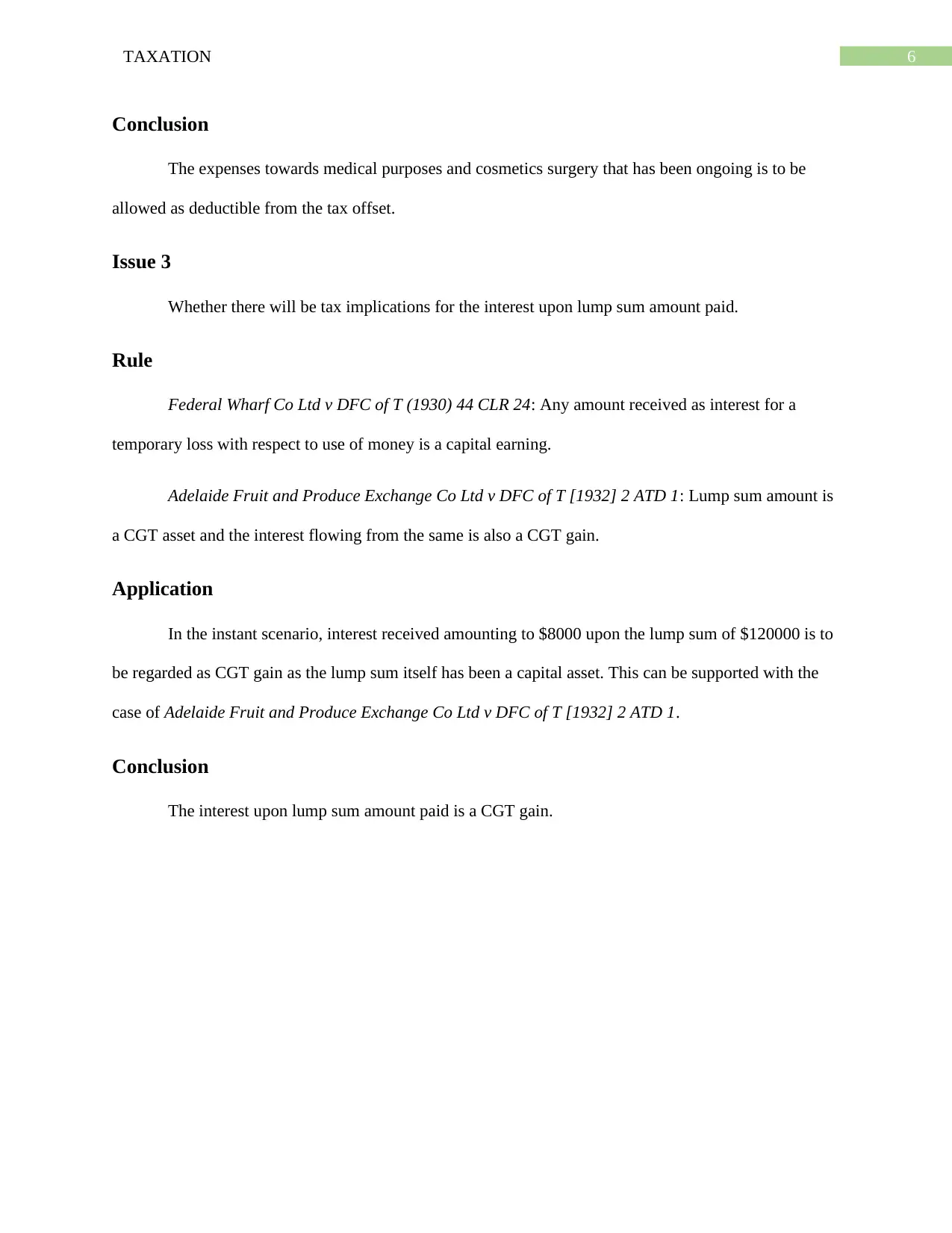
6TAXATION
Conclusion
The expenses towards medical purposes and cosmetics surgery that has been ongoing is to be
allowed as deductible from the tax offset.
Issue 3
Whether there will be tax implications for the interest upon lump sum amount paid.
Rule
Federal Wharf Co Ltd v DFC of T (1930) 44 CLR 24: Any amount received as interest for a
temporary loss with respect to use of money is a capital earning.
Adelaide Fruit and Produce Exchange Co Ltd v DFC of T [1932] 2 ATD 1: Lump sum amount is
a CGT asset and the interest flowing from the same is also a CGT gain.
Application
In the instant scenario, interest received amounting to $8000 upon the lump sum of $120000 is to
be regarded as CGT gain as the lump sum itself has been a capital asset. This can be supported with the
case of Adelaide Fruit and Produce Exchange Co Ltd v DFC of T [1932] 2 ATD 1.
Conclusion
The interest upon lump sum amount paid is a CGT gain.
Conclusion
The expenses towards medical purposes and cosmetics surgery that has been ongoing is to be
allowed as deductible from the tax offset.
Issue 3
Whether there will be tax implications for the interest upon lump sum amount paid.
Rule
Federal Wharf Co Ltd v DFC of T (1930) 44 CLR 24: Any amount received as interest for a
temporary loss with respect to use of money is a capital earning.
Adelaide Fruit and Produce Exchange Co Ltd v DFC of T [1932] 2 ATD 1: Lump sum amount is
a CGT asset and the interest flowing from the same is also a CGT gain.
Application
In the instant scenario, interest received amounting to $8000 upon the lump sum of $120000 is to
be regarded as CGT gain as the lump sum itself has been a capital asset. This can be supported with the
case of Adelaide Fruit and Produce Exchange Co Ltd v DFC of T [1932] 2 ATD 1.
Conclusion
The interest upon lump sum amount paid is a CGT gain.
Paraphrase This Document
Need a fresh take? Get an instant paraphrase of this document with our AI Paraphraser
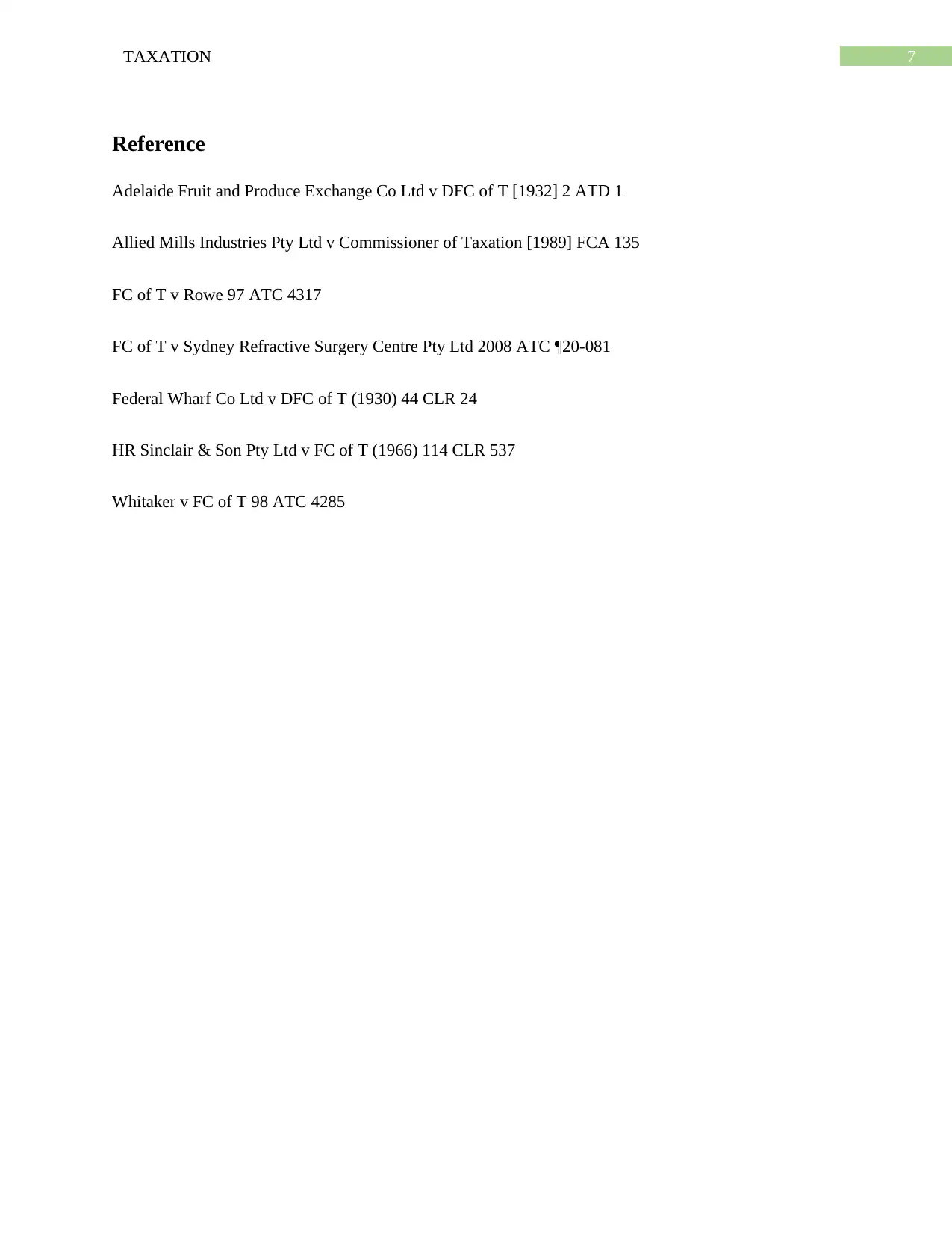
7TAXATION
Reference
Adelaide Fruit and Produce Exchange Co Ltd v DFC of T [1932] 2 ATD 1
Allied Mills Industries Pty Ltd v Commissioner of Taxation [1989] FCA 135
FC of T v Rowe 97 ATC 4317
FC of T v Sydney Refractive Surgery Centre Pty Ltd 2008 ATC ¶20-081
Federal Wharf Co Ltd v DFC of T (1930) 44 CLR 24
HR Sinclair & Son Pty Ltd v FC of T (1966) 114 CLR 537
Whitaker v FC of T 98 ATC 4285
Reference
Adelaide Fruit and Produce Exchange Co Ltd v DFC of T [1932] 2 ATD 1
Allied Mills Industries Pty Ltd v Commissioner of Taxation [1989] FCA 135
FC of T v Rowe 97 ATC 4317
FC of T v Sydney Refractive Surgery Centre Pty Ltd 2008 ATC ¶20-081
Federal Wharf Co Ltd v DFC of T (1930) 44 CLR 24
HR Sinclair & Son Pty Ltd v FC of T (1966) 114 CLR 537
Whitaker v FC of T 98 ATC 4285
1 out of 8
Related Documents
Your All-in-One AI-Powered Toolkit for Academic Success.
+13062052269
info@desklib.com
Available 24*7 on WhatsApp / Email
![[object Object]](/_next/static/media/star-bottom.7253800d.svg)
Unlock your academic potential
Copyright © 2020–2025 A2Z Services. All Rights Reserved. Developed and managed by ZUCOL.




